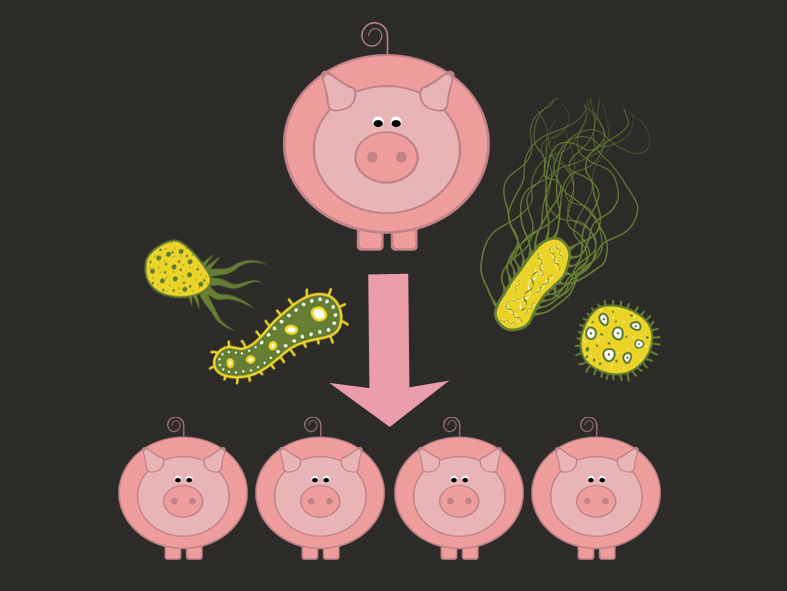21 Jun Intestinal health of the sow is closely related to piglet’s diarrhea

The role of the health of the sow is increasingly important to the productivity of the farms. Until recently, sow’s health was primarily focused on obtaining more pigs per sow per year and reducing non-productive days, but we know now that it is possible to enhance the health status of piglets by improving the condition of the sow (Miller, 2007).
Sows vertically transmit diseases to their litters, in two main ways:
- Transmission of infections inside the uterus (mainly virus, such as Porcine Epidemic Diarrhea Virus (Sun et al, 2012) or Porcine Reproductive and Respiratory Syndrome (PRRS) (Hady, 2013).
- Infection by contact of skin or mucosae between sow and piglet, during parturition or during lactation.
Pathogens that are the main cause of diarrhea in suckling pigs are also frequently transmitted through contact between sow and piglet:
- Clostridium species (C. difficile, C. perfringens): If the feces of a pregnant sow are infected with Clostridium difficile, the feces of all its litter become positive to C. difficile as early as 48 h after parturition. After less than 5 days, the healthy sows that surround the carrier become infected too and the bacteria can be isolated from the surfaces of the farrowing pens (Hopman et al, 2011).
- The presence of enterotoxigenic E. coli in the skin and feces of sows during the first week after parturition is common in farms with a history of diarrhea by colibacillosis in pre and post-weaning stages, while almost zero in healthy farms (Goswami et al, 2011).
- Sows infected by transmissible gastroenteritis virus (TGE) can transmit virus through milk or feces to their piglets. A sow infected with virulent strains sheds virus in her feces for 18 months. (Woods et al, 1998).
- Coccidia are initially introduced into farrowing facilities by carrier sows, by spreading the protozoa in the environment. Isospora suis is the most important coccidia specie affecting suckling piglets. In this case, the number of oocysts excreted by the sow plays a minimal or no direct role in the onset of the infection, being the spores found in the environment the most important factor (Lindsay et al, 1984).
Although piglets passively acquire antibodies against these pathogens from colostrum and milk, these defenses are limited and can be overwhelmed by large doses of microorganisms.
THE SOW GUT HEALTH STRATEGY
Besides direct action on piglet’s health, an indirect, smart and maybe easier way to prevent piglet’s diarrhea would be keeping sow’s digestive system healthy, focusing on the latest month of gestation and lactation stages.
Plant extracts have been reported as having antibacterial properties, stimulating digestion and enhancing immune status. Adding certain plant extracts to feed during late gestation and lactation has been shown to stimulate appetite, increase feed use, reduce fecal count of pathogenic microorganisms, improve sow immunity, boost antibody titer in colostrum and help to maintain a good body score.
All these benefits translate into improved health of the litter:
- Occurrence of diarrhea in suckling piglets is reduced.
- Weight at weaning is improved (weight at birth is generally not affected by the administration of beneficial plant extracts to the sow during gestation).
- Piglet’s intestinal morphology is better prepared for nutrient absorption and feed use (higher villus heights and wider surfaces of crypts).
PRODUCT OF CHOICE
ReproPlus® is a combination of plant extracts, organic acids, vegetal oils rich in omega-3 and a cocktail or European silicates, designed for pregnant and lactating sows.
It’s administration has a positive impact on the health of the sow. Preliminary trials showed that adding ReproPlus® to the feed during the last month of gestation, positively impacted the health of the piglets during the first two weeks of life.
MANAGEMENT MATTERS
Besides gut welfare, management and health programs are key to reducing vertical transmission of pathogens that cause piglet diarrhea. Here there are some important tips:
- Pay special attention to cleaning and disinfection of the farrowing pen before the sow’s arrival. Keep it as dry and clean as possible when the animals are inside.
- Wash the sows with warm water before entering the farrowing unit.
- Disinfect the teats just before placing the piglets under the sow. Disinfection could reduce the counts of E.coli in the skin of the sow by 99%.
- Body score is a highly visible indicator of the health of the sow. Ideally, sows should enter the farrowing pen with a body score of 3 and end lactation with a body score of 2.5.
- Work with your veterinarian to develop a specific vaccination program adapted to your farm.
- Establish a protocol to assess the health status of replacement gilts and new boars and a proper acclimatization time.
Literature of the article is available on request.

Certain health statements may not be applicable in your region.

